Trees Birds Mammals Fish Amphibians Reptiles
Wild Algarve
Bookshop
Phylum: Basidiomycota - Class: Agaricomycetes - Order: Gomphales - Family: Gomphaceae
Distribution - Taxonomic History - Etymology - Identification - Culinary Notes - Reference Sources
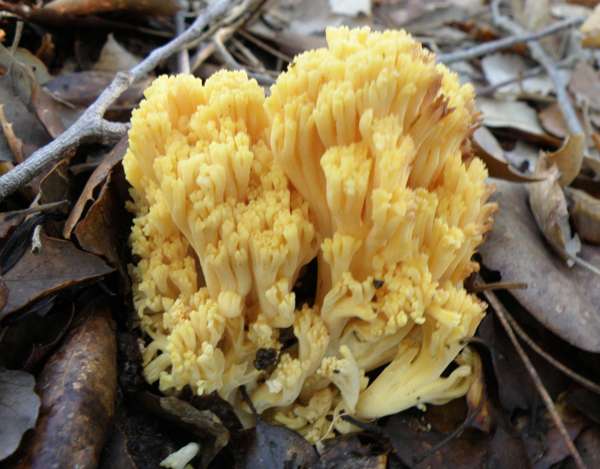
In Britain and northern Europe this is a rare coral fungus of broadleaf woodland, but it is relatively common in some parts of southern Europe. Ramaria flava varies in colour from lemon yellow to a bright sulphur yellow when young and fresh, but like so many woodland coral fungi it turns ochre and eventually brown when old.
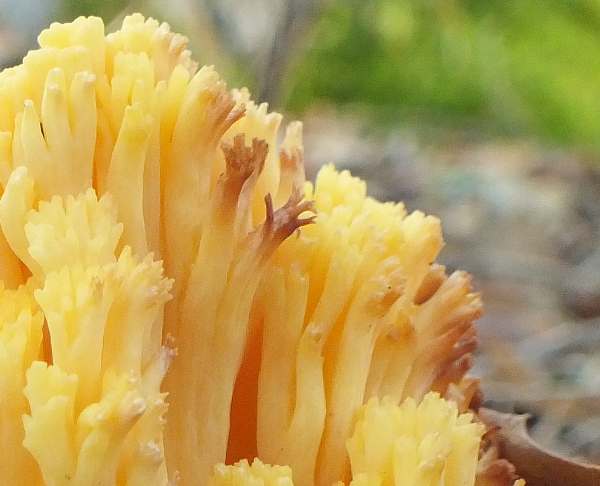
Distribution
Seen only very rarely in Britain and Ireland, Ramaria flava occurs also in many parts of mainland Europe, where it is increasingly common towards the Mediterranean and the Iberian Peninsula. This species occurs also in woodlands in parts of North America and has also been reported from Chile.
Taxonomic history
This coral fungus was described in 1763 by German naturalist Jacob Christian Schaeffer, who gave it the scientific name Clavaria flava. It was French mycologist Lucien Quélet who, in 1888, redescribed this species under its currently-accepted scientific name Ramaria flava.
Synonyms of Ramaria flava include Clavaria flava Schaeff., Coralloides flavus Tourn. ex Battarra, and Corallium flavum (Schaeff.) G.Hahn.
Etymology
Ramaria, the generic name, comes from Ram- meaning branch, with the suffix -aria meaning posessing or furnished with. Ramaria coral species are indeed furnished with numerous branches.
The specific epithet flava means yellow.
Identification guide
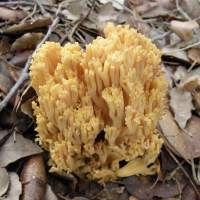 |
Fruitbody
When fully developed the whole fruitbody is usually 10 to 20cm tall, and up to 15cm across. Lemon-yellow to sulphur-yellow coral with many dense branches; the short stalk is 5-8cm long and 4-5cm across. The tips of the terminal branches bruise freddish; they are usually either blunt or have two or three points. When old this coral turns ochre progressing from the tips downwards. |
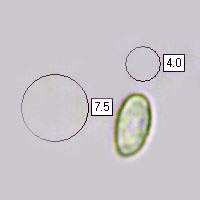 |
Spores
Ramaria flava var. flava has oblong-ellipsoidal to subfusiform spores, 11-18 x 4-6.5µm, with a rough surface; inamyloid. Ramaria flava var. parvispora has similar spores (shown here) but much smaller at 7-10 x 3.5-5µm.
Spore print
Orange-yellow (ochraceous). |
Odour/taste |
Odour not distinctive; taste mild. |
Habitat & Ecological role |
Mycorrhizal with hardwoods, in mixed or Beech woodlands. |
Season |
July to November in Britain and Ireland. |
Similar species |
Ramaria stricta is white or cream and its branches are more upright.
Yellow Clavaria corals are readily distinguished by their white spore prints; the spores of Ramaria fungi are yellow or ochre in mass. |
Culinary Notes
Ramaria flava is reported to be edible but of only moderate quality; however, it could easily be confused with Ramaria formosa, which is seriously poisonous, causing stomach pains and diarrhoea if eaten. There is another reason why this coral fungus should not be collected in Britain: it is a very rare find.
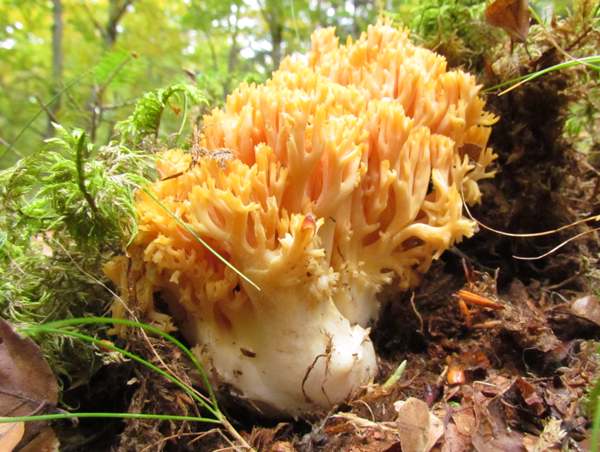
Reference Sources
Pat O'Reilly, Fascinated by Fungi, 2016.
Dictionary of the Fungi; Paul M. Kirk, Paul F. Cannon, David W. Minter and J. A. Stalpers; CABI, 2008
Taxonomic history and synonym information on these pages is drawn from many sources but in particular from the British Mycological Society's GB Checklist of Fungi.
Top of page...
Fascinated by Fungi. Back by popular demand, Pat O'Reilly's best-selling 450-page hardback book is available now. The latest second edition was republished with a sparkling new cover design in September 2022 by Coch-y-Bonddu Books. Full details and copies are available from the publisher's online bookshop...